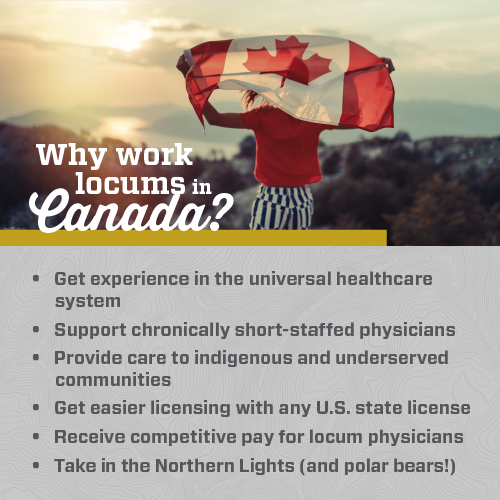
Taking a locum tenens job in Canada will give you the chance to explore the world’s second-largest country. But you’ll also be giving much-needed support to the understaffed physicians — and underserved patients — in Canada’s national health system, which ranks 26th out of 28 in other countries with universal healthcare. Before you decide if locum tenens in Canada is right for you, here’s what you need to know.

The Canadian healthcare system
Canada uses a universal healthcare system, whose system must “comply with the Canada Health Act’s five pillars: it must be universal, publicly administered, have comprehensive coverage, portable across provinces, and accessible to the population.” A high percentage of Canadians also buy private insurance or have employer-sponsored plans to help cover the cost of prescription drugs, dentistry, eye care, rehabilitative services, and home healthcare.
Having the chance to practice medicine in a universal healthcare system is a motivator for many doctors. Dr. Suneel Dhand shared his locums experience in an interview with KevinMD.com. “I got tired of hearing American doctors blasting the Canadian system, and others championing it, while neither had any idea of what they were talking about,” he says.

Dr. Dhand says what struck him most was, “How happy the doctors are; they are far from burnout and have a great work/life balance.”

Why Canada needs locum tenens physicians
In Canada, roughly 12% of the population does not have access to a regular medical doctor, according to The Canadian Institute for Health Information. This means that there are opportunities in both urban and rural areas.
Some rural assignments may give you the opportunity to serve indigenous and other underserved populations, where the physician shortage is especially acute. In the Northwest Territories, 45% of the population does not have access to regular medical care. Locums are one way the Canadian healthcare system tries to fill these needs.

Assignment details for locum tenens in Canada
For locum tenens jobs in Manitoba, Global Medical Staffing is partnering with general practitioner (GP) clinics in need of support. It’s relatively easy for board-certified, U.S.-trained physicians to become licensed to practice in Manitoba. However, as part of the licensing process, the province requires all U.S. physicians to undergo a monthly peer review with the clinic’s supervisor, who will review a handful of their clinical cases. The clinic supervisor also serves as a mentor on local resources and practices. In general, the supervision is more helpful than a burden.
For locum tenens assignments in Ontario and Nova Scotia, physicians with a license in any U.S. state can practice unsupervised. Juan Fernandez Mejia, senior recruiter at GMS, says, “Board-certified, U.S.-trained physicians with any state license can practice medicine in these provinces without supervision or exams. The licensing process has been streamlined and makes it easy for U.S. physicians to go and practice there.”
Locum tenens assignments in Canada can be as long as one year or as short as six months, and GMS will help with licensing, registration, and immigration.
What does locum tenens in Canada look like?
In Canada, locum tenens pay is similar to what doctors make in the U.S., but with some or all of housing and transportation covered too. Locum doctors also have four to six weeks of paid time off and usually get to spend more time with patients than in a typical U.S. setting.
Additionally, because of the universal healthcare system, doctors in Canada spend much less time on paperwork than in the U.S., a reason some doctors have chosen to relocate to Canada. One example is Dr. Emily Queenan, who was interviewed for an NPR story. The family doctor, who now practices in rural Ontario, grew up and did her residency in the U.S. After years of frustrating battles with insurance companies, she moved her practice to Canada.
Emergency medicine in Canada gets patients into treatment quickly, and patients get necessary preventive care, explains Dr. Steven F. Gordon, a Canadian doctor on Doximity. However, there can be a waitlist for certain procedures, like joint replacement. Also, doctors don’t practice defensive medicine, so some procedures like MRIs are only approved if truly necessary.
Explore Canada’s great outdoors
Canada is primarily an English-speaking country where the people are generally described as nice and easy to work with. The cost of living in Canada is typically the same or lower than in the U.S. Additionally, many locums contracts include housing and transportation, which can help offset some of the higher living expenses.

Standout attractions
The Great Bear Rainforest. “Stretching for more than 250 miles along the coast of British Columbia, the 21-million-acre wilderness is sometimes called the Amazon of the North,” reports National Geographic. “The vast, sodden land encompasses 1,000-year-old cedars, waterfalls spouting off the sides of moss-covered mountains, granite-dark waters, and glacier-cut fjords … coastal gray wolves, grizzly bears, Sitka deer, cougars, mountain goats, orca, salmon, sea lions, sea otters, humpback whales, and its most celebrated resident, the rare, cream-colored Kermode bear, or spirit bear, considered sacred by the T’simshian people.”
Banff National Park. Banff boasts world-class rock climbing, numerous hiking trails, biking trails, and lakes for canoeing, kayaking, and fishing. Enjoy the spectacular beauty of mountains, lakes, and valleys on a scenic drive or helicopter flight. In winter, you can cross-country ski, ice skate, snowshoe, go dogsledding, and more.
Whistler. Whether you love winter sports — like skiing and snowboarding — or summer sports like golf, hiking, and mountain biking, this is the place to do it, with miles of trails and numerous ski runs for all skill levels.
Old Quebec. This is a UNESCO World Heritage Site because it is an intact, fortified city. UNESCO explains that it was founded by the French explorer Champlain in the early 17th century and says, “It is the only North American city to have preserved its ramparts, together with the numerous bastions, gates and defensive works. The Upper Town, built on the cliff, has remained the religious and administrative centre, with its churches, convents, and other monuments like the Dauphine Redoubt, the Citadel, and Château Frontenac.”
Old Montreal. Check out the Basilique Notre-Dame, great food, shopping, cobblestone streets from 1672, the oldest public market in Montreal, museums, and more.
Victoria. Victoria is a Victorian-era city. “Few Canadian cities have done such a beautiful job of developing their waterfront area as Victoria and its Inner Harbour,” says Planetware. “This is a great place for strolling, relaxing, shopping, dining, and watching street performers all against the backdrop of the harbor.”
Polar Bears of Churchill, Manitoba. People flock to this town to see polar bears and the Northern Lights. The best time to go is in October and November, “when the bears begin their move from their summer habitat on the tundra back to seal-hunting territory — the pack ice that forms every winter over Hudson Bay,” according to Everything Churchill.

Plan your locums adventure
Taking a locum tenens assignment in Canada provides an opportunity to expand your clinical experience while experiencing our neighboring country to the north in ways only a local (or locums) can.
Interested in learning more about locum tenens in Canada? Give us a call at 844.917.4663 or view today’s physician job opportunities in Canada.



 Back
Back